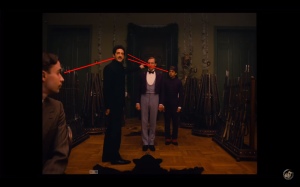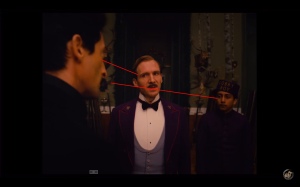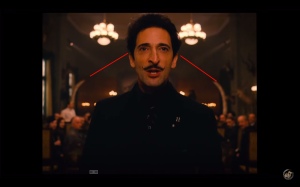Clara Mendiola
Student number: n9184074
Directed by: Wes Anderson
Starring: Ralph Fiennes, Tony Revolori, Adrien Brody
Release date: April 2014
Screen ratio: Switches from 1.85:1(intro) to 2.35:1 to 1.37:1(main body of film)
Image source: https://www.youtube.com/watch?v=eqrQBhw4YVg
Focalisers: (As annotated) People’s gazes are used to point our attention to who is speaking. The second image is a closed shot, as the focalisers are contained in the image. However, though we know who Brody’s character is speaking to, the first and second images are open shots as he looks outside the frame.
Mise-en-scene: Elements and characters in the frames spatially organised to create a balance; almost every shot in the film is symmetrical, with the audience’s attention often directed to the centre of the screen.
Montage: scene cuts from one character to the other as they speak. We move closer and closer to the main characters in the scene and the different shots add depth to both setting and characters.
Shot distance: shot distance changes from long shot, to three-quarters, to head and shoulders, becoming more ‘intimate’ as we are drawn closer to the characters–both visually and through dialogue.
Point of view: Point of view in long shot is from the characters sitting down, and the last shot is from Monsieur Gustave’s (Ralph Fiennes) point of view. The blurred background in the third shot further distances the crowd and focuses on Dmitri (Adrien Brody).
Sound: There is little sound in this scene, mainly parallel sounds (crowds gasping, punches, etc.), contrapuntal sounds in the end of the scene is the deep piano organ music to add dramatic effect as the scene ends with a head-and-shoulders shot of Jopling (Willem Dafoe).
Learning Outcomes:
Study of CI made me more aware of the different techniques used to create a film. It particularly helped build more appreciation for the quirky style that Wes Anderson incorporates in his films– and shows strengths in his work. Nearly every shot is symmetrical, the colour schemes are often continuous throughout the film, and appropriate sounds are applied to great effect.
Reference:
Gillian Rose. (2001). Chapter 2: The Good eye. In Gillian Rose,Visual methodologies : an introduction to the interpretation of visual materials, (pp.33 – 53).



